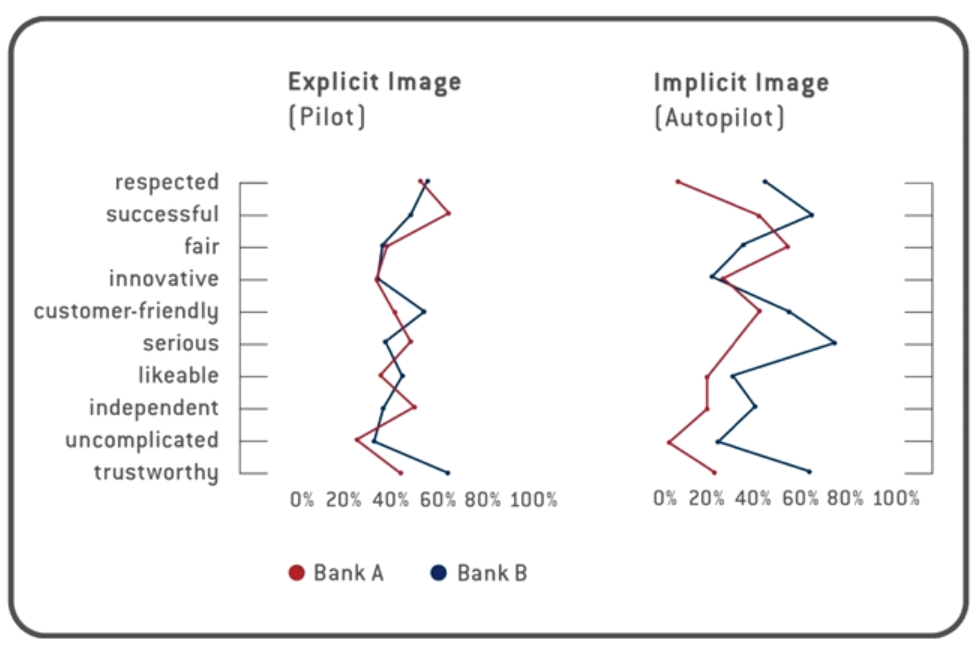
The Meaning and Nonsense of Brand Research - How to Conduct Effective Brand Research
From increasing brand awareness to brand building and from strengthening brand image to launching a new brand; most marketing department objectives revolve around the brand. This is not surprising, as the brand often plays a significant role in the decision-making process, even when the shopper is not consciously aware of it.
However, we immediately encounter a problem. If the shopper is not aware of the role of a brand in their choice, how do marketers determine that role? In this blog, we will discuss the meaning and nonsense of brand research. Moreover, we will reveal the ins and outs of various types of brand research such as brand asset research, brand image research and brand loyalty research.
By the way, recently we hosted a - free - lunch webinar exactly on this topic. In this webinar, Tim and Tom break down how you can truly measure your brand image.
Since you're reading this blog, we thought you would find this webinar really interesting! You can easily watch the recording through this link. I'm curious to hear what you think of it! 😇
What Strong Brands Have in Common
The Apple's and Coca-Cola's of this world make it clear; a brand is one of the most crucial assets of a company. While building a strong brand may initially seem to be about a strong proposition and creating love for your brand - we've all heard of the love brand - the reality in our brains is a bit different.
Our brains are associative by nature. Brands are, in essence, networks of associations. Brand building is the creation and reinforcement of associations with the brand in the consumer's mind.
These associations can be related to the category - creating brand awareness in this way - or to various other, more emotional associations - on which your brand image is based.
Since our brains are naturally lazy and prefer to make choices as easily as possible, brands are essentially helpers that make our choices easier.
Strong brands like Apple and Coca-Cola have numerous advantages. They are more frequently planned for purchase, stand out more, shoppers compare fewer alternatives, they are less price-sensitive, and the product experience is perceived as more positive.
But how do you build such a brand? A strong brand is the result of awareness and image. These are precisely the two basic ingredients of a strong brand.
Brand Awareness Research - A Matter of Brand Assets
Awareness is one of the basic ingredients of brand building. This makes sense: the more people know you, the more people will buy from you.
As a brand, you want to become a leader in the category and be recognizable. The primary way to increase brand awareness is by linking brand assets to your brand.
In this way, you literally expand the territory of your brand in the shopper's mind, making them think of your brand more often in purchase situations, causing your brand to stand out more, and ultimately resulting in more sales. Brand assets are thus the engine behind brand growth.
From Nike's recognizable logo to McDonald's "I'm lovin' it" slogan - all these distinctive brand assets help the brand claim a prominent place in the consumer's mind.
A good way to gain insight into the awareness and recognizability of your brand is through brand asset research. Here, you measure both the awareness of your brand assets and their uniqueness. What you don't want is for your brand asset to make the shopper think not only of you but also of the competitor. That way, all your marketing efforts also contribute to the competitor's success.
Brand Image Research
The second driver for brand growth is brand image. While associations with the category (i.e., the extent to which Coca-Cola is associated with the Soft Drink category) primarily increase brand awareness, numerous other associations contribute to the success of a brand.
If I were to ask you how much you would pay for sparkling water, what would you say?
Take the product below, for example. "Just" sparkling water. Yet, a twelve-pack of this product sells for $14 on Amazon. That is significantly higher than the average price for sparkling water. And the product performs well, as evidenced by the 26,000 reviews on Amazon.

This is the power of branding. This is what a strong brand image does. It makes people willing to pay not just $1 but $14, and they even reward it with 26,000 reviews.
A strong brand image not only makes people buy your product faster but also results in shoppers being much less price-sensitive. In other words, it enables you to charge a price premium.
So, it is definitely worthwhile to measure and strengthen your brand image. However, the way you do it determines whether it falls under the "Meaning" or "Nonsense" category.
Sometimes, brand image is explicitly measured by consciously asking about it. But that yields little distinctive data. The image below illustrates this well: the two banks hardly differ in terms of conscious brand image.

Source: Decoded, Phil Barden
However, when we look at implicit brand image research, we do see differences. This type of research exposes the unconscious nuances between brands.
Implicit brand image can be measured through reaction time tasks like the Implicit Association Test (IAT). Because we know: the faster someone can process a combination of two words or associations (such as a brand and an association), the stronger that association is anchored in the brand. Therefore, it is often more useful to measure the unconscious brand image than the conscious one. At Unravel, we regularly conduct brand image research for national and international brands.
There is a significant chance that if we had asked people why they bought Liquid Death in the example above, they would consciously think about it and rationalize their choice with answers like good quality. However, unconsciously, other motives are likely at play. Implicit testing provides a complete picture of the associations people have with your brand.
What about brand loyalty?
Increasing brand loyalty is a goal frequently discussed at boardroom tables. As a brand, we naturally want our customers to return loyally. But, as we wrote in a previous blog, the traditional thought assumes a customer becoming more attached to the brand until, over time, they do not put any other brand in their shopping cart.
However, when we look at sales data, that often turns out to be an illusion. Take Coca-Cola, for example. One of the most beloved brands globally. Although the overall market tends toward Coca-Cola, it is not divided into two camps. No, 41% of Coca-Cola buyers also buy Pepsi, and 72% of Pepsi buyers also buy Coca-Cola.
If almost the most beloved brand cannot achieve exclusive loyalty, the chances are slim that other brands can. Therefore, exclusive loyalty is often not a sensible goal, as it is rare and not a significant driver of growth. Loyalty is not the cause of brand growth but rather the result. For this reason, it is often wiser to measure other brand constructs such as awareness and image.
Gratis Webinar: "Hoe Meet je je Werkelijke Merkimago? 🧠"
Iedereen die ook maar iets met branding doet voelt dat Merkimago een essentieel stukje DNA is van elk succesvol merk. Maar wat is merkimago nu eigenlijk precies voor ons brein? Hoe vindt imago precies haar uitwerking op koopgedrag? En hoe kun je zoiets onbewusts als merkimago eigenlijk meten?
Tijdens dit webinar leer je:
👉 Neuromarketing & Merkimago: Wat is merkimago in het brein?
👉 Hoe merkimago de shopper beïnvloedt
👉 Hoe meet je daadwerkelijk merkimago?
De 60 minuten durende webinar is nu terug te kijken!
Bekijk de webinar via deze link. <
Key Takeaways
- Strong brands have in common that they are both well-known and possess a positive brand image.
- Despite the previous emphasis on the love brand, our brains work differently. Our brains are associative, and brands are nothing more than networks of associations in our minds. Brand building is the creation and reinforcement of associations.
- If you want to gain insight into the awareness and recognizability of your brand, a solid brand asset research is important. Here, you measure both the awareness of your brand assets and their uniqueness.
- Measuring brand image through explicit questioning results in a distorted view. This is because brand image is largely unconscious. If you really want to know how your brand is experienced in the consumer's mind, you can use implicit research, which measures the strength between two associations through reaction time.
- Loyalty is not the cause of brand growth but rather the result. Therefore, it is often wiser to measure other brand constructs such as awareness and image to assess the health of your brand.






